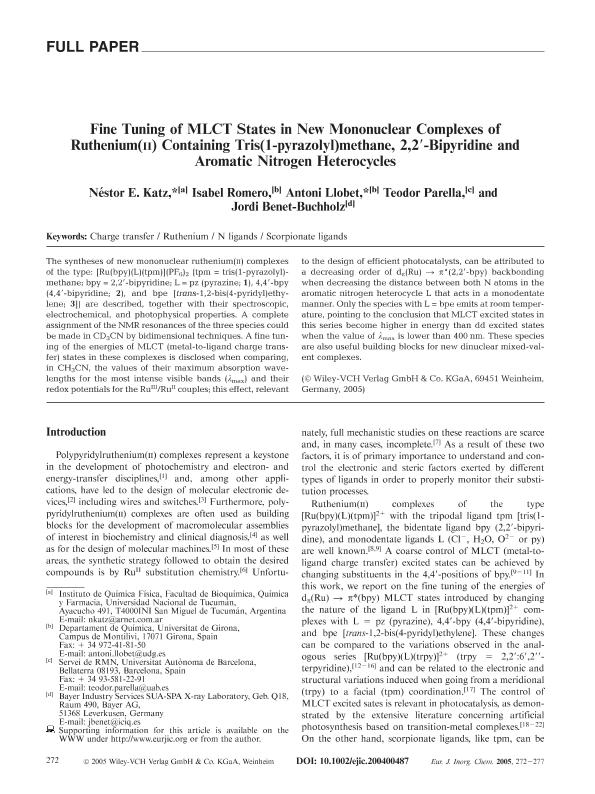Artículo
Fine tuning of MLCT states in new mononuclear complexes of ruthenium(II) containing tris(1-pyrazolyl)methane, 2,2′-bipyridine and aromatic nitrogen heterocycles
Fecha de publicación:
01/2005
Editorial:
Wiley VCH Verlag
Revista:
European Journal of Inorganic Chemistry
ISSN:
1434-1948
Idioma:
Inglés
Tipo de recurso:
Artículo publicado
Clasificación temática:
Resumen
The syntheses of new mononuclear ruthenium(II) complexes of the type: [Ru(bpy)(L)(tpm)](PF6)2 {tpm = tris(1-pyrazolyl)-methane; bpy = 2,2′-bipyridine; L = pz (pyrazine; 1), 4,4′-bpy (4,4′-bipyridine; 2), and bpe [trans-1,2-bis(4-pyridyl)ethylene; 3]} are described, together with their spectroscopic, electrochemical, and photophysical properties. A complete assignment of the NMR resonances of the three species could be made in CD3CN by bidimensional techniques. A fine tuning of the energies of MLCT (metal-to-ligand charge transfer) states in these complexes is disclosed when comparing, in CH3CN, the values of their maximum absorption wave-lengths for the most intense visible bands (λ max) and their redox potentials for the RuIII/Ru II couples; this effect, relevant to the design of efficient photocatalysts, can be attributed to a decreasing order of dπ(Ru) →*(2,2′-bpy) backbonding when decreasing the distance between both N atoms in the aromatic nitrogen heterocycle L that acts in a monodentate manner. Only the species with L = bpe emits at room temperature, pointing to the conclusion that MLCT excited states in this series become higher in energy than dd excited states when the value of λmax is lower than 400 nm. These species are also useful building blocks for new dinuclear mixed-valent complexes. © Wiley-VCH Verlag GmbH & Co. KGaA, 69451 Weinheim, Germany, 2005.
Palabras clave:
CHARGE TRANSFER
,
N LIGANDS
,
RUTHENIUM
,
SCORPIONATE LIGANDS
Archivos asociados
Licencia
Identificadores
Colecciones
Articulos(INQUINOA)
Articulos de INST.DE QUIMICA DEL NOROESTE
Articulos de INST.DE QUIMICA DEL NOROESTE
Citación
Katz, Néstor Eduardo; Romero, Isabel; Llobet, Antoni; Parella, Teodor; Benet Buchholz, Jordi; Fine tuning of MLCT states in new mononuclear complexes of ruthenium(II) containing tris(1-pyrazolyl)methane, 2,2′-bipyridine and aromatic nitrogen heterocycles; Wiley VCH Verlag; European Journal of Inorganic Chemistry; 2; 1-2005; 272-277
Compartir
Altmétricas




